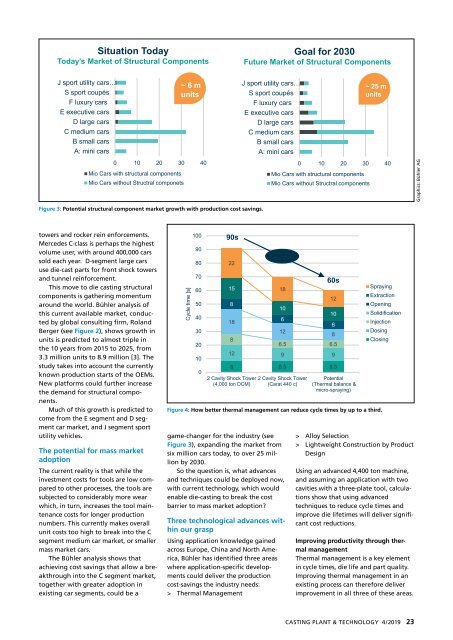CPT International 4/2019
You also want an ePaper? Increase the reach of your titles
YUMPU automatically turns print PDFs into web optimized ePapers that Google loves.
Situation Today<br />
Today’s Market of Structural Components<br />
Goal for 2030<br />
Future Market of Structural Components<br />
J sport utility cars…<br />
S sport coupés<br />
F luxury cars<br />
E executive cars<br />
D large cars<br />
C medium cars<br />
B small cars<br />
A: mini cars<br />
0 10 20 30 40<br />
Mio Cars with structural components<br />
Mio Cars without Structral componets<br />
~ 6 m<br />
units<br />
J sport utility cars…<br />
S sport coupés<br />
F luxury cars<br />
E executive cars<br />
D large cars<br />
C medium cars<br />
B small cars<br />
A: mini cars<br />
0 10 20 30 40<br />
Mio Cars with structural components<br />
Mio Cars without Structral components<br />
~ 25 m<br />
units<br />
Graphics: Bühler AG<br />
Figure 3: Potential structural component market growth with production cost savings.<br />
towers and rocker rein enforcements.<br />
Mercedes C-class is perhaps the highest<br />
volume user, with around 400,000 cars<br />
sold each year. D-segment large cars<br />
use die-cast parts for front shock towers<br />
and tunnel reinforcement.<br />
This move to die casting structural<br />
components is gathering momentum<br />
around the world. Bühler analysis of<br />
this current available market, conducted<br />
by global consulting firm, Roland<br />
Berger (see Figure 2), shows growth in<br />
units is predicted to almost triple in<br />
the 10 years from 2015 to 2025, from<br />
3.3 million units to 8.9 million [3]. The<br />
study takes into account the currently<br />
known production starts of the OEMs.<br />
New platforms could further increase<br />
the demand for structural components.<br />
Much of this growth is predicted to<br />
come from the E segment and D segment<br />
car market, and J segment sport<br />
utility vehicles.<br />
The potential for mass market<br />
adoption<br />
The current reality is that while the<br />
investment costs for tools are low compared<br />
to other processes, the tools are<br />
subjected to considerably more wear<br />
which, in turn, increases the tool maintenance<br />
costs for longer production<br />
numbers. This currently makes overall<br />
unit costs too high to break into the C<br />
segment medium car market, or smaller<br />
mass market cars.<br />
The Bühler analysis shows that<br />
achieving cost savings that allow a breakthrough<br />
into the C segment market,<br />
together with greater adoption in<br />
existing car segments, could be a<br />
Cycle time [s]<br />
100<br />
90<br />
80<br />
70<br />
60<br />
50<br />
40<br />
30<br />
20<br />
10<br />
0<br />
90s<br />
22<br />
15<br />
18<br />
12<br />
8<br />
10<br />
10<br />
18<br />
6<br />
6<br />
12<br />
8<br />
8<br />
6.5 6.5<br />
12 9 9<br />
8 8.5 8.5<br />
2 Cavity Shock Tower 2 Cavity Shock Tower<br />
(4,000 ton DCM) (Carat 440 c)<br />
game-changer for the industry (see<br />
Figure 3), expanding the market from<br />
six million cars today, to over 25 million<br />
by 2030.<br />
So the question is, what advances<br />
and techniques could be deployed now,<br />
with current technology, which would<br />
enable die-casting to break the cost<br />
barrier to mass market adoption?<br />
Three technological advances within<br />
our grasp<br />
Using application knowledge gained<br />
across Europe, China and North America,<br />
Bühler has identified three areas<br />
where application-specific developments<br />
could deliver the production<br />
cost-savings the industry needs:<br />
> Thermal Management<br />
60s<br />
Potential<br />
(Thermal balance &<br />
micro-spraying)<br />
Figure 4: How better thermal management can reduce cycle times by up to a third.<br />
Spraying<br />
Extraction<br />
Opening<br />
Solidification<br />
Injection<br />
Dosing<br />
Closing<br />
> Alloy Selection<br />
> Lightweight Construction by Product<br />
Design<br />
Using an advanced 4,400 ton machine,<br />
and assuming an application with two<br />
cavities with a three-plate tool, calculations<br />
show that using advanced<br />
techniques to reduce cycle times and<br />
improve die lifetimes will deliver significant<br />
cost reductions.<br />
Improving productivity through thermal<br />
management<br />
Thermal management is a key element<br />
in cycle times, die life and part quality.<br />
Improving thermal management in an<br />
existing process can therefore deliver<br />
improvement in all three of these areas.<br />
CASTING PLANT & TECHNOLOGY 4/<strong>2019</strong> 23

















